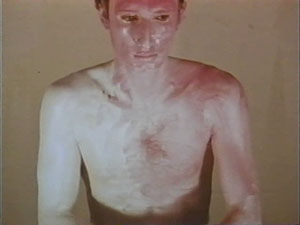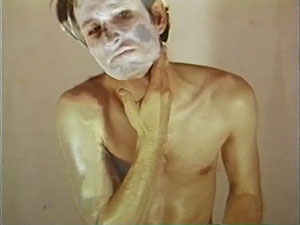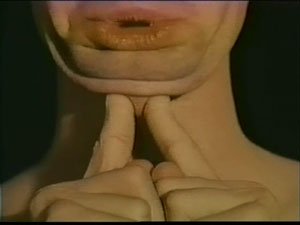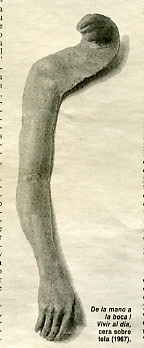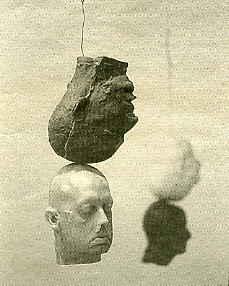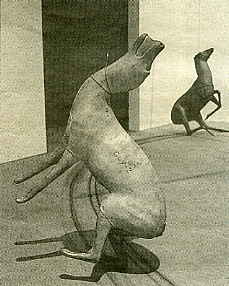"Hear
here
Interview
An interview with Bruce Nauman about his commission for the Turbine Hall
at Tate Modern, poetry, architecture, sound and language
Raw Materials comprises text pieces that since 1966 have been critical
parts of Bruce Nauman’s work – read on the page, spoken and
sung in audio works and videos, seen illuminated in neon and chiselled
in stone. Using existing material, Nauman recorded some of these texts
for the first time and re-recorded others. For this installation he has
orchestrated 21 audio selections for the totality that fills the apparently
empty volume of the Tate’s Turbine Hall – a space that is
150 metres long, 35 metres high and 23 metres wide.
Distinctively long, tall and (relatively speaking) narrow, the Turbine
Hall conjures up the imagined vast underground tunnels for which Nauman
made large- scale models as sculptures some three decades ago. By contrast,
Raw Materials takes up the vast chamber and promises to be a Conceptual,
experiential work of colossal scale and intimate subtlety.
As a precise sculptural gesture, Nau-man’s installation is responsive
to the details, the processional plan and the geometries of the space.
Within the emptiness visitors will navigate by sound and sense. By moving
through the linear demarcation of voices traversing and newly structuring
the open space, they will individually find in the repetitions and echoes
something of the poetics of Gertrude Stein’s ‘no there there’ but
at the same time quite literally those of Nauman’s ‘hear’ ‘here’.
The repeat of the two homonyms, part of a text engraved on a steel plate
for a 1968 sculpture, First Poem Piece, is heard in one of the audios
at the Tate.
Reading First Poem Piece (which on the page and as an audio is titled
You May Not Want To Be Here) makes evident Nauman’s spatial play,
his poetic gift and his direct address to his audience, and offers the
best
introduction I can think of to these qualities in Raw Materials at Tate
Modern.
you may not want to be here
you may want to be here
you want to be here
you want to be
you may want to be
you may not want to be
you may not want
you may want
you may be
you may not be
you may not be here
you may be here
you may not want to hear
you may want to hear
you want to hear
you may not hear
you may hear
you hear
Joan Simon: Why audio rather than sculpture or video – or a combination
of any of these – in the Turbine Hall project?
Bruce Nauman: The first time I saw the space, or one of the first times,
at the far end they had a Henry Moore sculpture exhibition. 1 And when
they were first showing me the space, I realized the cranes in the space
were still functioning. So the first thing I thought of was picking up
the Henry Moores and flying them around. [Laughs]
That’s especially funny given the way you’ve called on Henry
Moore before in your work – in the 1967 Light Trap for Henry Moore
photos, and the wax sculpture Henry Moore Bound to Fail (back view),
among others.
Anyway, that was the first thing I thought of. At one point I was starting
to think about this fish project I’ve been working on …
The large-scale fountain …
Yes, and for the Tate, there was an idea of having these fish all over
the place, but the space is so enormous. When you are in there you become
aware of the sound of the turbine engines on the other side of the building.
There weren’t people in the space when I first visited; maybe I was
in there after hours. It’s a constant kind of drone, a pleasant kind
of sound. Actually, it’s almost a meditative kind of sound, and
it changes as you move around in the space. It resonates more in certain
places
than in others, and you become less aware of it as a larger number of
people are in the space. You have to look for it or listen for it. So
that may
be the reason I thought of a kind of sound piece. Then I started looking
for directional speakers so that I could isolate sound.
How are the speakers installed?
Down the length of the space, there are these vertical I-beams, about seven
metres apart. When we started, I was hanging the speakers in the spaces
between the I-beams, but they became too much like a picture, an image,
an object. So I decided to hang them on the beams and that gave me my spacing,
which was a very nice interval installed.
I put them on both sides of the space, opposite each other, so I could
have the same texts coming from different speakers or I could have different
texts but from the same group or project.
Where did you begin?
When Dennis Diamond [of Video D] and I started out, we just pulled all
the ones we could find that had been recorded, so that I could listen
to all those. Some I knew I wanted: THANK YOU; OK; WORK; some of the
NO NOs.
The short ones came first, and then some of the ones that were slightly
longer, like the ‘Clown Torture’ stories.
Then Fergus Rougier [Sound Directions Ltd] brought a tape with him that
was a generic white noise kind of tape. He said this would simulate the
sound of the space when there’s a lot of people in it. It’s
a great tape. It sounds like when you’re in a restaurant, or you’re
in a hotel lobby, an airport – conversations you’ll never understand.
It puts a kind of flat background in. So instead of using his sound on
that tape, we decided to use the turbine sounds, which you really can’t
hear unless the museum is empty. Then I had Dennis make some tapes where
I went BRRRRR BRRR BRRRR and MMMMMMMMMMMM, and it was working OK. Then
Fergus said, ‘Let’s just try one of them, and see how it works
by itself.’ He went home and tried working with it, moved it up and
down a little bit. So we decided to use the MMM only. It’s almost
got a little bit of a La Monte Young sound. Resonances and beats as you
move around the space.
A lot of artists during the late 1960s and early ‘70s were making
text works. Some of them were instructions; some were lists of actions
or activities; some were actually writing poetry.
There was a magazine that I read when I was at school: Art & Literature.
There was always a lot of poetry, there would be interviews, and there
were, I think, descriptions of things. It was an interesting range of stuff,
and it opened up ways of thinking about things, and I learned what other
people were doing. Art & Literature – better than Arts & Leisure,
a better programme.
For staged photographs in the 1960s the titles add a last something.
Sometimes the photographs are illustrations of the ideas, and sometimes
the titles are the explanation of the objects.
And the relation of word to image?
Sometimes it was an excuse, sometimes it was sort of misdirection, an
excuse or a reason for making something – in a way, labelling something
that didn’t have a purpose and giving it a purpose.
After using words, for example, in a 1967 neon, The True Artist Helps
the World by Revealing Mystic Truths (Window or Wall Sign), or titling
photos
such as Waxing Hot (1967), for a work in which you’re seen polishing
the red letters of the word H O T, you soon start making sound pieces
using audio tapes.
The first one I did, the one I think is the first piece, is Six Sound
Problems for Konrad Fischer [1968], but I had made the audio pieces before.
I remade
all those tapes in Germany for the Konrad Fischer piece. A lot of those
were conceived as performance ideas, and I had bought a cheap 16mm camera
at a pawn shop when I was still in school [at the University of California,
Davis] and filmed some stuff, but then when I moved to San Francisco
there was a big underground film thing, so a lot of people had equipment.
And
I had the idea for performances, but not really a venue, and it didn’t
occur to me to rent a space.
In Six Sound Problems for Konrad Fischer you were using the actual recording
tape not just for audio but also as a changeable sculptural element.
It became a way of dividing the space.
And you did two artist’s books, Burning Small Fires (1968) and Clear
Sky (1967–8), that ‘cut’ the space of words. So that
Clear Sky reads as …
Clea Rsky
And Burning Small Fires, which is related to [Ed] Ruscha’s artist’s
book, Various Small Fires.
Urning all Ires is what it looks like. How it reads.
What about Get Out of My Mind, Get Out of This Room, from 1968, included
in the Tate selections?
What I did then was to hide the speakers in the walls in an empty room,
and the sound reverberated.
It’s not just what you are saying in ‘Get Out of My Mind, Get
Out of This Room’, but how you are saying it.
I felt like there was a lot of pressure. I had the show at Leo’s
[Leo Castelli Gallery], and a show before that in 1968 with Konrad Fischer
and then I was in a lot of group shows in New York and Europe. I felt like
over that winter of 1968–9 everything I thought of got used up. When
I went back to California, I felt really intruded on. People were demanding
things. That’s what it felt like. I wanted to move, and a lot of
that piece was connected to that feeling I had of being devoured. Maybe
it’s why I decided I couldn’t stay on the East Coast. I didn’t
know if I could separate myself. I didn’t know if I could separate
myself enough from this attention, and physically even, if it was possible
to take myself out of that. I don’t know if it was true, or if
it would have made a difference, no matter what.
The Amplified Tree Piece, (1969). Did you think this could be monitored,
or was it about conceiving a mental space?
Well, it worked. At least two people heard it. Stanley and Elyse [Grinstein]
said you could hear leaves blowing, people talking, and if everything was
still and no one was in the yard near the tree, just a quiet hummmm.
Could you talk about First Poem Piece (1968)?
When we did record it for the Tate project, I did it first as a computer-generated
voice. You programme the kind of voice you want and you just type into
the computer the words you want – for First Poem Piece the words:
YOU MAY NOT WANT TO BE HERE [see full text above]. And I had the computer
say the words just as sentences. Then I had the computer say the words
just as beats where the blank spaces would be – it goes silent for
a metronomic period of time, then says the words that are on there. And
then we did it also with a kind of intuitive gap. When Alexander [Ziffer
Diamond] does his reading, he sort of does it all three ways. Dennis had
his four-year-old son Alexander read it, who can’t read of course.
So Dennis had to give him a reading, and he’s just so good. This
kid’s voice is so good. As he’s reading, he gets annoyed at
Dennis, and that’s when the really great sound levels start to change.
His understanding of what was being said was probably greater than the
computer voices’s understanding, but still not in it, in the poetic
sense at all.
You actually use the word ‘poem’ in the title.
I was thinking about Concrete poetry, spacing of the words on the page.
Could you describe the scene or situation in San Francisco at the time
you began to write some of these texts?
There was ‘penny poetry’ given away free – the hand-outs
that were around.
Did you go to poetry readings?
Some. I remember we went to the first human be-in in Golden Gate Park.
Allen [Ginsberg] was there reading and chanting.
Do you ever think of yourself as a writer?
Not really. Most of those texts, the long ones, as well as the little short
ones, are the result of a lot of editing. A lot of writing that gets more
and more condensed. I thought of it as more poetic than literature.
Elements of architecture and sound are used in Touch and Sound Walls and
Sound Breaking Wall (both 1969). For the latter you used two audio tapes.
One of them is you exhaling, and one is of you pounding, laughing.
The idea was of the whole room being the sound, the whole room resonating,
really locating the sound.
No longer your isolated corridors.
It gets rid of the objectness, all that stuff.
It seems that these two pieces are precedents for what you are doing in
the Turbine Hall.
Yes. That and Get Out of My Mind.
In 1969–70 you make the acoustic wedges and acoustic walls.
What they’re using is ambient sound. As you move next to something
that is sound- absorbing, you feel a pressure change, and then you move
away from that. So it’s manipulating the ambient sound that’s
in the room – a kind of sculptural manipulation of audio space.
The text from the neon sculpture One Hundred Live and Die (1984), also
used as an audio component at the Tate, began as a neon sculpture.
The first time I recorded it was for the show in Belgium [‘Chambres
d’amis’]. Actually, the first time I did it was in Germany,
for Haus Esters. So it went from being drawings, then the neon, then
spoken.
What are the differences for you, in terms of the piece’s effectiveness,
in each of the variant forms?
I don’t know. It’s just different. There’s the immediate
visual sensation in the large neon. The programming is almost like fireworks.
Whoa! Look at that one! And, especially in the English way we recorded
it, it is almost like chanting. It’s instructional, demanding.
Another shift is when you use a text, such as Left or Standing, Standing
or Left Standing (1971), in tandem with a room-size installation. 2
With Standing or Left Standing I think that it wasn’t entirely
clear to me that there was a connection between the space of the gallery
and
the text that was being handed out. And then it did become one piece.
Then when I did it as a video [in 1999], it fades in two verses, and
one verse
goes back and forth, sounds into the other.
Cones Cojones (1973–5)?
That’s a little more direct because actually in that case the tape
on the floor becomes almost an illustration, or a visual aid to the text.
The text is asking you to imagine a physical description, and the tape
is an illustration of where you’re supposed to be imagining it
passes through the gallery. The Mask of Rock is a much more abstract
relationship.
In the Consummate Mask of Rock installation (1975) the relationship is
between the stones in unmatched ‘pairs’– and then also
the relationship between the overall field of limestone sculpture and
this emotionally devastating text.
The coldness of the stone without the text. Thinking about the text disorients
you in the space.
An alternate title for that piece is The Mask to Cover the Need for Human
Companionship.
Yes. I really can’t say, other than they got put together in my
mind and presented that way. Well, there was a divorce there. [Laughs]
I almost
forgot for a minute.
These are very long texts ...
…
and they’re all cut and pasted too. I cut them up and taped them
and cut them up and re-taped them. You can do it on your word processor
now, but that was the way it was done then, with scissors and tape or paste
or whatever. Again, it’s going back to Concrete poetry. I had to
take a lettering class when I was in college. One of the things that was
really interesting and one of the main things where I really learned a
lot was when we used to have to take home and copy by hand a reproduction
of a medieval manuscript with an actual quill pen, and then bring it back,
and the guy would put it upside down on the wall, hang it upside down and
say, ‘see it doesn’t scan, it doesn’t read’.
In the audio version entitled Anthro/Socio, as in the video installations
of 1991 and 1992, the words are sung.
I was doing stuff myself, and then I realized that that particular piece
needed a professional, or needed somebody who had a voice, rather than
me saying it, and I had worked with Rinde [Eckert] before, so I asked if
he would work on it. He has the opera training, and has a good voice and
presence.
Where did the melody come from — him or you?
He did it. I just gave him the text and asked him to improvise on it. We
worked, and shot a lot of stuff.
And those words?
It’s a text that I wrote, over some time. I remember I had versions
of it pinned on the wall for quite a while and I kept changing it around.
How much editing do you do in the writing, and then after, in the recording.
On the recordings I try and find the best takes. I almost never have
edited tapes. Do it once, get the ones I like. On writing the texts,
of course,
there’s a lot of editing. Almost always, the result of trying everything,
but that’s the way I work. I have some sort of idea about something,
get involved in all other ways you could do it, and then try to get it
back – get it down to the simplest, most straightforward estimation.
And sometimes that’s really close to what I started with, and sometimes
it’s not.
It’s a very nice way to open the Tate show, to say THANK YOU to
your audience at the beginning.
I immediately thought that would be the first piece – so they would
get thanked on the way in, and they would get thanked on the way out.
Originally you had sent that tape as an actual thank you.
I thought of it as a piece. It was a thank you, but it was a piece. I
sent it to Ydessa Hendeles as a thank you after Susan [Rothenberg] and
I had
come back from Toronto, and it was thanking her for taking us to a horse
show, and getting us on the airplane. David Byrne after a concert one
night said thank you that way. He said THANK YOU THANK YOU. It was a
very aggressive
thank you, and so that’s what I did. And I was doing those works
WORK WORK (1994) , and those things, which fit.
The arrangement of texts within the hall is, in a sense, symphonic.
When I was presenting my idea of using the texts to the people at the
Tate, they called it sampling, a musical sampling and using it like a
musical
arrangement. The title of the piece is Raw Materials – it’s
using this other stuff in an abstract way, in a way without getting involved
with the meanings of the texts, but using the rhythms and the textures
of the texts, and how they relate to each other, and how they make their
own new meaning in the whole thing so that you never really have to understand
any one of them, in the way you would if it was presented by itself. And
in a way – this isn’t quite true – it allows me to deal
with the material without getting emotionally involved with it, and what
it was about the first time. I mean I still could do that, and some of
them have different involvements, but I was thinking that could be kind
of difficult – I couldn’t have put it together if I had to
think about it in that way. Maybe the closest thing it’s related
to is Mapping the Studio because it’s using stuff that’s
left over, in another context.
If you had to catalogue Raw Materials for a museum: is it an installation,
a sculpture, an audio piece?
[Laughs]
How do you conceive of it spatially, visually?
Actually, I’ve been thinking about it because it comes out of dealing
with that space. Clearly it can go somewhere else, but never the same way
it is there. You might never have that size space, in the first place.
And you can’t compact it too much. You could change things around,
you could add some stuff, take some stuff out. Present it at a smaller
scale perhaps, but it will never be the same. Anyway, I don’t know.
I always still call myself a sculptor.
1 ‘Henry Moore: Public Sculptures’, Tate Modern, Turbine
Hall, 19 May - 25 August 2003. For comments by Nauman on Moore, and a
detailed
discussion of his reaction to the critical reception of Moore c. 1966
and his incorporation of his responses into his own work see Coosje van
Bruggen,
Bruce Nauman, Rizzoli, New York, pp. 110-111.
2 Installation with Yellow Lights (Castelli Installation with Yellow Lights),
1971/99. As made in 1971, the piece included the printed text component
Left or Standing, Standing or Left Standing. In 1999, the text component
was made as a video and shown on a monitor.
Joan Simon
Joan Simon, a Paris-based writer and independent curator, was recently
named Curator-at-Large, Whitney Museum of American Art, Ne”.
![]()
